by Chet Bodin
October 2014
Much has been made of the so-called 'brain drain' particularly in rural areas separated by distance and culture from the state's major metropolitan areas. This concept is often based solely on the exodus of 15- to 29-year-olds who leave hometowns for educational opportunities, career prospects, or to broaden their horizons.
Without question, population data show geographical movement of younger age groups. However, this trend typically is discussed out of context. The migration of people ages 15 to 29 is the rule rather than the exception in both rural and urban areas. Unfortunately, rural communities sometimes interpret the loss of their youth as a reflection on their community rather than a societal norm occurring throughout the state and country.
Since 2000 the only counties in Minnesota that experienced an increase in those busy 20- to 24-year-olds are home to four-year postsecondary institutions. In Northwest Minnesota Beltrami, Clay, and Stevens counties all welcomed net in-migration, with Beltrami and Clay expanding more than 25 percent between 2000 and 2010. Since 2000, all other Northwest Minnesota counties experienced net out-migration among 20- to 24-year-olds, as did every other county in the state without a university. Rather than some phenomenon unique to rural communities, data show that the loss of younger populations is constant among all counties without a four-year university (Figure 1).
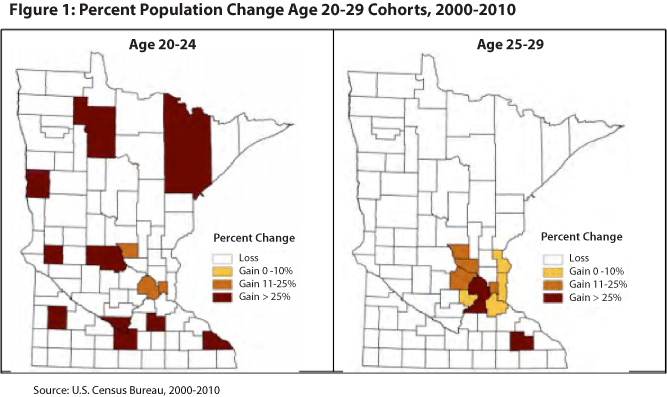
U.S. Census data and new analysis from regional researchers and the University of Minnesota's Ben Winchester have identified other demographic shifts in Minnesota as well, adding significant nuance to the discussion of rural population changes.1 Instead of a 'brain drain', many counties are experiencing a 'brain gain'. Winchester's research has pointed to an increase in population cohorts aged 30 to 49 in most rural Minnesota counties in what's known as the 'rural rebound'.
Using the Simplified Cohort Approach, age cohorts from 2000 were examined against 2010 data to capture how, if no migration took place, the expected number of people matched up to actual population numbers a decade later. For example, if Northwest Minnesota had 20,000 people aged 20 to 29 in 2000, the same number of people would be 'expected' to comprise the 30- to 39-age cohort in 2010. The difference between the expected number and the actual number represents the net in- or out-migration of a region or county.
Figure 2 shows that most counties in Northwest Minnesota saw an increase in the number of 30- to 39-year-olds from 2000 to 2010. According to the research, workers in these age groups are at the peak of their careers and often contribute more to their communities at large. Additionally, they are often highly educated, and bring more connections and resources from other areas.2
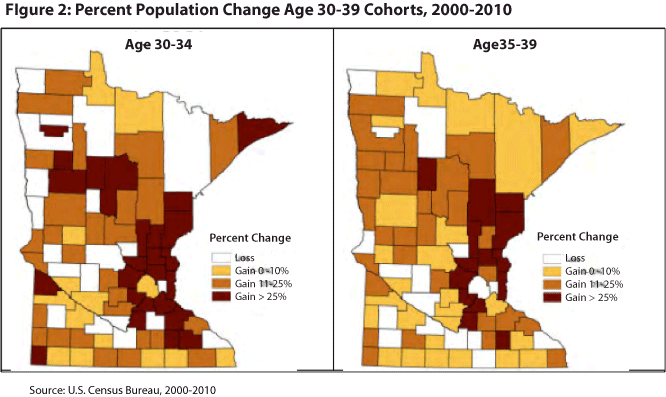
In Northwest Minnesota only Clay and Polk counties are designated as Metropolitan Statistical Areas, with Clay part of the Fargo-Moorhead MSA and Polk part of the Grand Forks-East Grand Forks MSA. While a good case can be made for an urban label for Beltrami County which has Bemidji State University, the remaining 24 rural counties traditionally find that a good portion of their young adults leave the area for other opportunities. Besides Clay with Moorhead State University and Stevens with the University of Minnesota-Morris, only Beltrami County with Bemidji State University experienced a net migration intake among the 20- to 24-year-old age cohorts from 2000-2010.
Current data estimates from the U.S. Census Bureau's American Community Survey allow migration patterns in Northwest Minnesota to be examined from the end of the recession through the current recovery. Rather than the 10-year period used in prior research, this article compares cohorts over a five-year span from 2009 to 2013. In the five-year timeframe age groups are examined in the following cohorts: 25 to 34, 35 to 44, and 45 to 54.
These age ranges coincide with those often tracked for industry employment demographics, which adds context on workforce demographics to the overall analysis, and their activity can be significantly relevant to job seekers and employers alike.
Since the end of the recession, migration trends throughout rural Northwest Minnesota mirror those found previously in rural areas across the state. There were nearly 6,000 fewer people ages 20 to 24 in rural Northwest Minnesota than expected, indicating an approximate 20 percent migration out of the region in this age group. But again, out-migration among 20 to 24 years old's is the rule, not the exception (Figure 3).
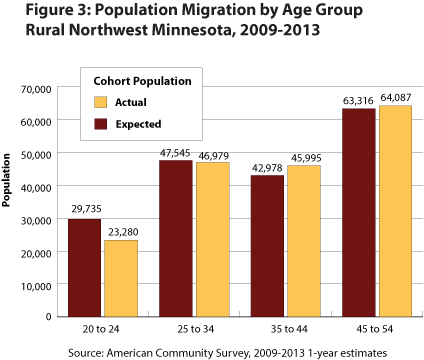
On the surface this sounds dire, but when compared to the earlier study examining 2000 to 2010, the amount of out-migration of 20-24 year old's actually decreased. In 18 of the 23 rural Northwest counties studied here, there was out-migration of more than 40 percent among this age group from 2000-2010 (Figure 4).
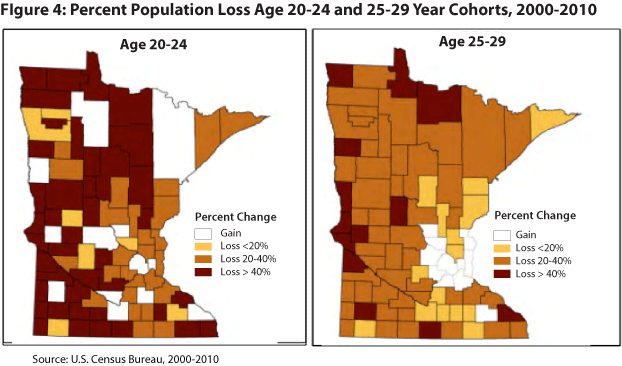
Net out-migration occurred among 25- to 34-year-olds in Northwest Minnesota as well, where approximately 566 (1.8 percent) fewer were found in 2013 than in 2009. But considering that from 2000 to 2010 the average Northwest Minnesota county experienced a 20 to 40 percent net migration loss in ages 25 to 29 alone3, the current trend is encouraging. From 2009-2013 Northwest Minnesota lost only 13 percent of people in this age cohort, while it added nearly as many individuals ages 30 to 34 in that time (Table 1).
| Population Change, 25-34 Year Old Cohorts, 2009-2013 | ||||
|---|---|---|---|---|
| Age Cohorts | Expected Population | Actual Population | Migration Number | Migration Percent |
| 25-29 | 25,573 | 22,162 | -3,411 | -13.3% |
| 30-34 | 21,972 | 24,817 | 2,845 | 11.5% |
| Total | 47,545 | 46,979 | -566 | -1.8% |
| Source: American Community Survey, 2009-2013 1-year estimates | ||||
This upward trend among 30- to 34-year-olds continues to offset the loss of 25- to 29-year-olds in the post-recession years. What's more, the loss of people in the 25 to 29 cohort looks to be diminishing. From 2000-2010, there was at least 20 percent out-migration in every Northwest county except Crow Wing (Figure 4).
Just as important to the economic health of the Northwest, if not more so, are the 35- to 54-year-old cohorts. These individuals make intangible contributions to their local economy and communities. As leaders, workers, and parents, their experience and know-how is rarely paralleled by younger generations. The Northwest not only maintained a high level of experience and expertise by retaining people in these age groups, but also continues to attract people in this demographic category. To anyone who's ever experienced the harsh conditions of a Northwest Minnesota winter, their in-migration speaks volumes about the region's economy and overall quality of life.
Altogether, Northwest Minnesota experienced a net out-migration of nearly 6,000 residents ages 20 to 24 and a net in-migration of approximately 2,000 people in age groups 25 to 54. Major gains appear to have occurred in the 30- to 44-age range to counter the continued out-migration among ages 25 to 29. More importantly, those migrating to the region are more experienced and educated, while those leaving are often just beginning their education and careers.
How does this translate to the workforce in Northwest Minnesota? Research shows that population cohorts ages 30 and above are returning to the region and have a lot to offer, but it's less clear what effect their arrival is having on the regional workforce. Manufacturers and most other industries in the Northwest should be elated to learn about this rural renewal, if it isn't already apparent. The manufacturing industry has added almost 3,000 jobs since 2010, with many new workers from the 25- to 44-year-old age groups (Figure 5). Industry subsectors with the most new hires among these ages were Fabricated Metal Product Manufacturing, Wood Manufacturing, Food Manufacturing, and Transportation Equipment Manufacturing.
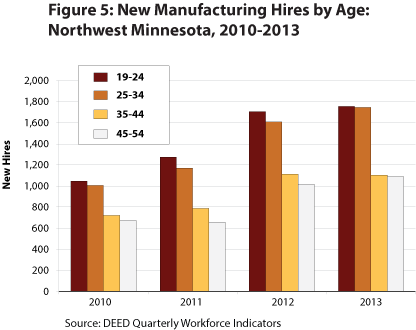
New hires in these age groups are often well educated, work-tested, and bring various connections with them to the industry. This is not to say younger workers are bad hires - far from it. Statistically speaking, they are simply more likely to migrate out of the area for other opportunities. Instead, the tenure of middle-age workers is often longer and turnover rates are lower, making the employer's investment more apt to pay off (Figure 6).
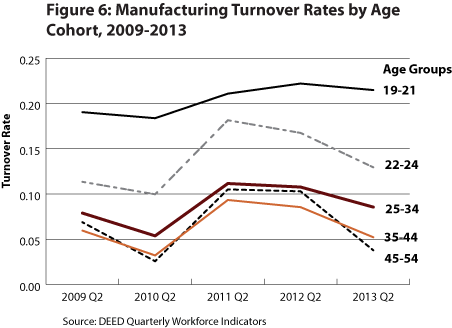
While there is more to be explored, early research contradicts conventional wisdom that a loss of talent is plaguing rural areas in Northwest Minnesota. On the contrary, the rural renewal in Northwest Minnesota indicates our communities and industries are benefitting from a talent in-migration that offsets the typical out-migration of young adults to college towns and elsewhere. While this revelation falls short of answering all the challenges faced by Minnesota's rural communities, it has reenergized the conversation among community leaders about what can and should be done to welcome and retain newcomers. More specifically, rural communities may obtain a better grasp of who is moving to their communities, what needs they have, and what amenities they value.
Interestingly, most of the middle-aged migrators moving to the Northwest are doing so for the quality of life rather than the quantity of jobs. In 2010, survey research by the Upper Minnesota Valley Regional Development Commission (UMVRDC) found that the top reasons for migration to rural Minnesota were 1) a desire for a simpler life, 2) safety and security, 3) affordable housing, 4) outdoor recreation, and 5) for those with children, locating a quality school. Surprisingly, jobs were not listed among the top 10 reasons people relocated to rural areas.4
But most newcomers to the Northwest need good jobs too, and the manufacturing industry has been more than happy to provide them. Further research on where this influx of talent is finding work should also be of significant interest to employers and other job seekers.
1"Brain Gain in rural Minnesota."
2"Continuing the Trend."
3"Continuing the Trend."
4Ben Winchester Report.